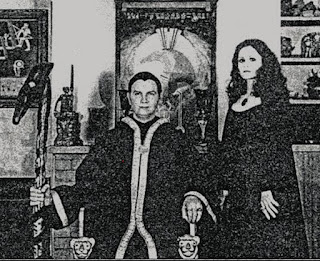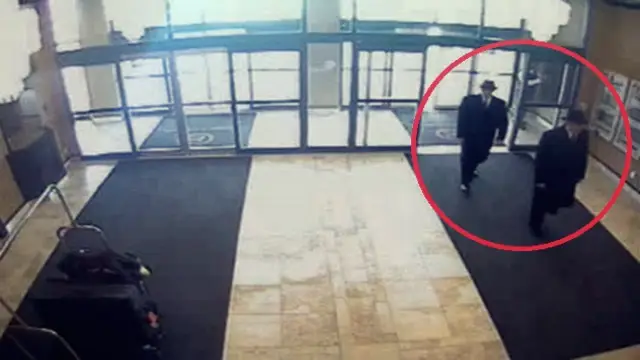Stranger Things works a lot of well-tilled plots, familiar riffs from countless 80s horror and (predominantly) sci-fi films. But it also taps into real-life horrors that were playing out in the media in the early 1980s; the highly-publicized abductions of children, the rise of conspiracies over child trafficking, organized pedophilia and government coverups and the role of 24-hour TV news in feeding the fear over what seemed like a new plague descending over the country.
This is the unspoken backdrop that animates the tension over Will’s disappearance, for any of you who might think that Winona Ryder’s performance was a bit over the top.
And if you look carefully the producers inject some none-too-subtle symbolism in the scenes surrounding Will’s captivity in the Upside Down, symbolism that signals to more salient horrors than extradimensional tulpas.
So if you wonder why so many American parents seem overprotective and paranoid these days, realize that many of them were kids themselves during the early 1980s when this media firestorm arose over the series of shocking kidnappings and/or murders of young children.
These took place in an already-heightened atmosphere of social anxiety, in large part fed by an endless deluge of slasher and serial killer movies and a series of Satanically-inspired crimes and serial murders.
There was also the fact of Satanism popping up again and again in crimes and abuse cases. While there is an ongoing controversy over the existence of Satanic Ritual Abuse on an organized scale, there’s widespread agreement that it’s common among individual abusers.
Certain investigators involved in the Cropsey case (which we looked at in the previous post) believed that there was ritual aspects to it and other high-profile abduction cases in the New York metropolitan area in the 1980s.
JZ: Frank Saez is one of the most knowledgeable detectives when it comes to the missing children cold cases in New York City, and he was very instrumental in bringing the Etan Patz case to trial. It is believed that Etan was taken by an individual and passed along to a cult of sorts, so he’s very sensitive to the idea that a cult could be behind the disappearance of a child. I don’t think however we’re talking about “devil worshipping cults” per se, but more as cults that engage in pedophilia.
It just so happens that of one of the cults mentioned in the film, The Church of the Process, the former leader lives in Staten Island, so the proximity of that cult definitely put the police in high alert as to the possibility that one could be behind the disappearance of these kids.
There was also the steady stream of Satanic-themed movies, books and records following in the wake of the creation of the CIA’s Project MKOFTEN, coinciding with the rise of emotion-based, anti-intellectual movements within Christianity such as Pentecostalism and Charismaticism, which were also fed and financed by elements in and around the intelligence community.
Many of these movements fed their congregants a steady diet of anti-occult paranoia and sensationalist televised “exorcisms”, creating a heightened climate of fear and vigilance.
What inevitably resulted was an explosive social tension, a culture being buffeted by powerful internal pressures.
To top it all there was the constant ratcheting up of tension between the governments of the United States and the Soviet Union in the early 80s, instilling widespread nuclear anxiety all across the world.
So when kids began disappearing, and doing so under the specter of clandestine Satanic forces (many of which hinted at much greater conspiracies lurking like sharks beneath a placid surburban surface) the panic that followed was not only not irrational, it was in fact inevitable.
One such case was the 1981 abduction and murder of six year-old Adam Walsh by the serial murderer- and avowed Satanist- Ottis Toole.
Toole lured Walsh from a department store, then repeatedly raped the boy before he murdered and decapitated him, incinerating the body and discarding the severed head, which was later found by fishermen.
Toole was the sidekick of Henry Lee Lucas, a prodigious serial killer whose death sentence was inexplicably commuted by Texas Governor George W. Bush. Walsh’s father would become an anti-crime crusader and host of the long-running TV show, America’s Most Wanted.
There was also the case of Rachel Runyon in 1982:
Three-year-old Rachael Runyan was abducted from the city playground behind her home in Sunset, Utah on August 26, 1982 by a black man driving a blue midsize car. Twenty-one days later, her body was found dumped in a creek off a dirt road in Morgan County. Years later, a disturbing message was found in a bathroom of a local business. The author claimed responsibility and suggested that the murder was part of a Satanic ritual or cult.
Police intially dismissed any connection to Satanism until a disturbing event a couple years after the girl’s abduction:
(W)hen Rachael’s father visited her grave, an unexplained black rose lay on the stone. Then, two and a half years after the murder, the following message appeared on a stall door in a 24-hour Laundromat: “I’m still at large . . . I killed the little Runyan girl! Remember Beware!!!!” Below it was an inverted cross with three number sixes, one at each arm and the head of the cross. Psychologists associated with the case said the real killer quite possibly wrote it.
Then there is the long-running and puzzling case of Johnny Gosch, well-known to most in the conspiracy and parapolitics communities. This case would become a major news story, thanks mostly to the tireless work of the boy’s mother.
Gosch would become one of the first kids to appear on a milk carton, and would later connect to the Jeff Gannon controversy during the George W. Bush Administration :
On September 5, 1982, 12-year-old paperboy Johnny Gosch arose before sunup and set about his work delivering the Sunday Des Moines Register to the good folks of sleepy, suburban West Des Moines, Iowa. Most times young Johnny would roust the elder John, his father, to accompany him on his route, but Johnny was 12 now and the time had come for him to test his mettle and go it alone… He hasn’t been seen since.
American parenting hasn’t been the same since, either. Johnny’s disappearance triggered mass hysteria and moral panic among parents nationwide….The abduction marked the advent of “stranger danger,” and in the aftermath, a story would unfold as chilling as it was unbelievable, and one that haunts families in Iowa to this day…
What later became obvious was that there was a predator with a paperboy fetish, prowling the streets of Iowa:
Barely two years later, the case takes an unexpected, if not nightmarish turn, when 13-year-old Eugene Martin is plucked off a Des Moines street while delivering papers in the early hours, a bag left behind, half-full of abandoned newspapers, the lone proof that he was ever there.
The local police department’s behavior was so phenomenally, so stultifyingly, inept it can’t help but feed into coverup theories. The local chief of police was especially obstructive, so much so that the Goschs would threaten the township with a major lawsuit (leading to the chief’s firing) and later accuse him of involvement in the kidnapping.
The FBI wasn’t any better. The Feds’ stonewalling, as captured in the documentary film Who Took Johnny?, is so blatant and unapolgetic you can’t help but wonder what exactly is lurking beneath the surface here.
Ultimately, the Gosch family were so frustrated by the lack of cooperation from law enforcement that they were forced to hired private detectives to help find their son.
But nine years after the boy’s disappearance there’d be a major break in the case.
(C)onvicted sex offender, Paul Bonacci, who comes out of nowhere in 1991 to claim he was there when Johnny was abducted, working as an accomplice, and that he knows for a fact that Johnny is still alive. While imprisoned in Lincoln, NE, Bonacci goes on tape to tell investigators he helped physically subdue Johnny, forcing him into the car, before chloroforming him to unconsciousness in the back seat.
This wasn’t merely a criminal confessing his crime, however. Bonacci’s sudden admission from behind bars pulls back the curtain on an endlessly layered, labyrinthine conspiracy that would implicate high-level power-brokers around the country.
(Bonacci) tells police that his role in Johnny’s kidnapping was only one of countless crimes he’d been coerced into at gunpoint by his own abductor, a man known only as The Colonel.
The Colonel, it turns out, is the nom de guerre of a high-level operative in a vast organization of predatory pedophiles operating a very lucrative human trafficking operation.
At first blush, this might sound like typical smoke blown by a convict looking for a deal, but Bonacci was able to provide Noreen Gosch with details about Johnny and the abduction that were not released to the media.
And to tie this all back to the overarching context of OFTEN and its tentacles, Bonacci would identify the Colonel by name:
According to Bonacci, the abduction was ordered by Lt. Col. Michael Aquino, who later picked Gosch up at a farmhouse he was being held at and delivered him to a buyer in Colorado. For years, both boys were used for the pedophiliac pleasures of high-ranking government officials.
Michael Aquino was a Psychological Warfare Specialist in the US Army from 1968 until 1990, when he was involuntarily discharged as a result of investigations into his involvement in the ritual sexual abuse of children at the Presidio Day Care Center in San Francisco.
Throughout this same time, he has also been a devout satanist and self-confessed neo-Nazi. He joined Anton LaVey’s Church of Satan in 1969, staying until 1975 when he left to start his own Temple of Set, which has been in operation ever since.
For his part, Aquino would assiduously deny all of these claims, going so far as to write a book to deny them and similar claims of involvement in abuse (you can read Aquino respond to charges against himself in the comments section here). And Aquino is a relatively public figure who makes for an easy target.
But there’s far too much smoke around him for there to be no hellfire.
Aquino’s involvement in all of this may actually be to play the designated villain, a visible target meant to draw fire away from other offenders who might compromise players further up the chain of command.
The original target in the Presidio scandal was a Baptist minister named Gary Hambright.
Why does this matter? Read on:
Assessing the veracity of Paul Bonacci’s story requires a close look at an explosive scandal unfolding in Omaha, Nebraska between 1988 and 1991, contemporary with Bonacci’s confession…
Prominent businessman and political figure, Lawrence King, was head of the Franklin Community Federal Credit Union in Omaha from the late eighties to the early nineties. (King) was also a rising political figure, holding various prominent positions within the Nebraska GOP, even appearing twice at the Republican National Convention to sing the National Anthem. …In hindsight, it must have been apparent that he had some secondary income, and he did — $38 million’s worth, all embezzled from the credit union he was tapped to run.
According to several witnesses and alleged victims, King was the facilitator of an enormous pedophile operation. Franklin Credit Union had been established as a benefactor of Omaha’s Boys Town, a hallmark of the city widely lauded as one of the world’s best charities for disadvantaged youth.
Accusers claimed that King used the partnership with Boys Town to pimp out poor, homeless adolescents to wealthy donors and shot-callers.
Nothing ever came of the Boy’s Town accusations and several investigators and interested parties declared there was a systematic and thorough coverup of the scandal, involving many of the region’s most powerful and influential personalities.
Remember that this scandal- as well as the Presidio scandal- was a long time before the wave of abuse scandals that would rock the Catholic Church. For many, abuse by members of the clergy would be unthinkable.
Consider this: what if a highly visible, loathesome, visually distinct and unforgettable cartoon villain like Michael Aquino was conveniently onsite to draw fire away from a Baptist minister and the priests who ran Boy’s Town, ensuring that the boat would not be rocked and that business would carry on as usual?
Meaning of course that the supply chain of vulnerable children to abusers would not be disrupted. After all, most Satanists don’t have ready access to kids. Clergy do.
Nothing much would come of the accusations against Aquino and he’d later shrug it all off as the product of scapegoating and witch-hunting. Remarkably effective diversionary tactics, when all is said and done. You’d almost think it was the brainstorm of someone involved in psychological warf…
Oh.
Speaking of diversionary tactics, we will see in a future post that the widely-controversial “Satanic Panic” of the 1980s and 90s directly coincided with a growing panic within the Catholic Church over priestly abuse.
In fact, a decades-long study had produced a 1985 report within the Church alerting leadership that they were sitting on a timebomb.
The Satanic Panic not only helped to divert attention away from the abuse cases that were beginning to emerge in local media in the 80s and 90s, it would also discredit the use of hypnosis and recovered memory in treatment of adult survivors of childhood abuse and intimidate many individuals into silence.
Cui Bono?, indeed.
BRANDED
Furthering his credibility as a witness, Bonacci would later take a camera crew from America’s Most Wanted to the ranch where he said kidnapped kids were being warehoused.
(Bonacci) leads the film crew into a scene shown exactly as he’d described it; a pit dug beneath the home, where he says he was stowed away for safe keeping until the next buyer showed up. What Bonacci showed American viewers next was even more harrowing: names and messages carved into wooden joists, which he claimed were desperate breadcrumbs left behind by the victims of commercial pedophilia.
But that wasn’t all. There was another alleged victim there that day, a runaway by the name of Jimmy. Jimmy had previously described the house in fine detail, said he too had been stashed there, and bore a branding on his skin to prove it. Known as “The Rocking X,” the brand was seared into the flesh of trafficked children. Bonacci had previously mentioned it to investigators, well before they’d ever heard of Jimmy.
A similar story- including branding and Satanists using Christian institutions as cover for procuring children- would emerge from England during this period as well. From 1982:
A judge today jailed two couples after hearing how they indulged themselves in devil worship and a “web of sexual corruption” with young children.
One of the men believed he was the devil incarnate and found handmaidens in his former Salvation Army wife and sister-in-law, Northampton Crown Court was told.
Malcolm and Susan Smith of Southgate Sutton Hill Telford,and Albert and Carole Hickman of Chockleys Meadow Leegomery Telford, all pleaded guilty to a series of serious sexual offences against young children.
One 15 year old girl who was brought in became so convinced he was Satan that she allowed him to brand her with a hot dagger, he said.
Present-day Satanists reactively chafe at any mention of this sort of thing, dismissing any discussion of satanically-motivated crime as hysteria and sensationalism. They’ll insist they are rationalists and atheists and that the sturm und drang ritualism and is purely symbolic.
Which is exactly what Anton LaVey said 50 years ago.
Unfortunately, it didn’t take very long for it all to filter down to Satanic serial murder once it left the smug and smarmy precincts of upscale San Francisco.
You see, the problem with Satanism is not the Bohos and hipsters flirting with Satan for the lulz and the shock value, the problem is when the inherent Satanic implication of absolute license and transgression crosses over from irony to action.
More often than not this happens with the more marginal and lower-educated, but there’s all kinds of evidence that Satanic depravity can effect the rich, jaded and bored with an equal intensity (see Savile, Jimmy et al). And there’s all kinds of evidence that Satanism often dovetails with- and feeds into- extreme right politics as well.
This implied license is embedded into every scrap of Satanic symbolism, iconography, scripture and lore. This is what the unconscious mind actually processes. It’s why I personally find Satanic imagery so hard to digest.
Never mind LaVey’s (or whoever) half-hearted bromides and commandments, look at the track record.
I’m not talking about the Occult (Satanism has never struck me as particularly occultic, actually), or witchcraft or whatever else gets lumped into the Satanic woodpile.
After all, nothing gets labeled as Satanic by amateur devil-hunters more enthusiastically than that other church across the street there.
I’m not even talking about “Luciferianism”, whatever exactly that means (and it can mean anything because it doesn’t actually objectively exist).
I’m talking about Satanism.
You see, what I’m trying to say is that in an atmosphere of economic decline, war, social disintegration, terrorism, racial tension and general pessimism about the future, maybe this mainstreaming of Satanism- after-school clubs and all the rest- isn’t really what we need to be playing with right now.
It very much feels as if someone is pouring kerosene on a pile of well-cured kindling. And old newspapers and oily rags.
It’s just itching for a match.




























